Walk around the church, look at the walls
Hover on each image, to see it's title.
|
 Hi,
Hi,
Longhope (hope means an enclosed valley) belonged to the Abbey of Lyra in Normandy and then to the priory of St Mary and St Florence in Monmouth, as recorded in a taxation return dated 1299. In 1340 it was transferred to the Crown and the first traceable incumbent was inducted on 1 Oct 1340.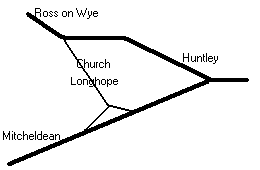
All Saints is located on Church Lane, a link route from the Mitcheldean road and the Ross on Wye road to bypass the traffic lights at the Huntley intersection. Parking is restricted to the church side only.
Longhope had a private woodland in 1327, excluded from control by the Crown and Forest laws. The church goes back before records. Stonework suggests Norman or earlier existence, completed in the 12th century with a Tower, much altered in the next two centuries, then in the 19th century a new vestry and organ chamber were built and the tower was given a new top.
|
Walk clockwise around All Saints with me.
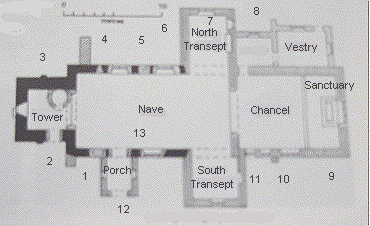
The numbers refer to small images on this page.
If the image has a purple border,
click on it to go to an enlarged version,
then click that image to return to this one. |
1. Beside the Tower
2. Tower entry
3. South of tower
4. South wall
5. South wall
6. South wall
7. Effigy
8. North Transept
9. 15th century window
10. Judith's monument
11. Priest's Door
12. Sundial
13. Royal Arms of William III
Porch
Nave
Chancel
South Transept
|
|
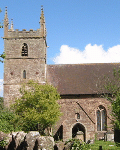

|
Approach the church from the south, and see the sections, Tower, Nave, and Chancel. The South Transept is hidden by the tree. The churchyard wall is barely visible on the left. The grounds are dotted with tombstones. An early pedestal tomb is to John Constance died 1816, placed between the porch and the trancept
|
|
Longhope appears to be one of the earliest Forest churches to have a Tower, as Mike Salter comments 'Longhope has a Norman Tower at the west end of the Nave, the position which was to become the norm for towers in the later medieval period'.
Step left from the Porch and see the first buttress for the Tower stands about 2 metres west. This detail shows evidence of an earlier doorway, before the present porch was constructed.
The tower construction began in the 12th century, described by David Verey in the book 'Gloucestershire 2' - 'Only the first two stages of the tower are medieval, the lower one with central pilaster buttresses and a crude-looking south doorway. The upper two stages are by AW Maberly 1869-70 with embattled parapet and big crocketed pinnacles.'
Mike Salter, in his 'Parish Churches of the Forest of Dean', comments that the tower has one original window.
The Tower has a large buttress on the south side, creating an alcove between it and the North Transept, which was added in the 13th century.
|

|
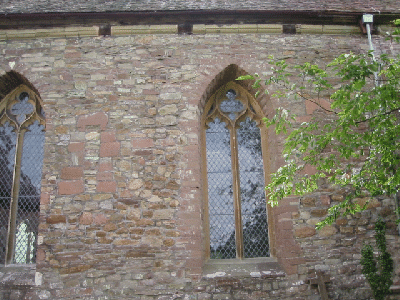 The North wall has two windows, each with a blocked-up Norman window to its right, with different cap-stones.
The North wall has two windows, each with a blocked-up Norman window to its right, with different cap-stones.
|

|
The Norman churches had small windows and doorway with round headed caps. Is the version with the rectangular excision for the window an earlier example of the art of making window spaces?
Other blocked-up windows can be seen on the exterior of the South wall of the Chancel.
These together indicate the wide nave dates from these early days.
The new windows are tall narrow openings with a pointed arch, placed in pairs and then tracery decorating the spandrel - the space between the window heads.
|
|
The church was made cruciform, probably in the early 14th century, with small lower transepts. The thickness of the walls is shown by the inner window detail (of the window in the eastern wall). The external view of the western wall shows the Norman style of the window. In the 1920's maintenance work resulted in the discovery of a small window in the north transept.
|
Norman window in South wall.
The Chancel south wall is described as having a blocked lances, a trefoiled lancet set higher up, a 13th century priest's doorway and a two-light Perpendicular window.
The map of the church shows this blocked window was part of the redesigning of the 19th century.
|
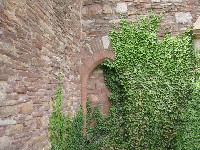 The church is a working building, shaped to suit the needs of the resident community.
Early Christians needed a church as a place where prayers were said on a regular basis, for their souls. A resident priest was needed, and the this image shows the Priest's Door to the Chancel, possibly suggesting he lived there. This also reminds us that traditions suggest the Verger had a living space either above the entry or in the bell-tower.
The church is a working building, shaped to suit the needs of the resident community.
Early Christians needed a church as a place where prayers were said on a regular basis, for their souls. A resident priest was needed, and the this image shows the Priest's Door to the Chancel, possibly suggesting he lived there. This also reminds us that traditions suggest the Verger had a living space either above the entry or in the bell-tower.
|

|
The entry Porch is dated around 14th century, and has three steps down to floor level. Modern features include the wrought iron lantern and coloured glass window.
Much older is the Sun Dial showing 14.30. Notice the sun dial is at an angle.
|
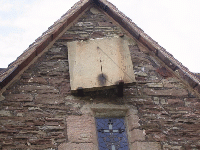
|
|